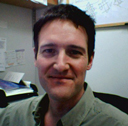High risk of conversion to multiple sclerosis predicted by gene activity

Sergio E. Baranzini, PhD
Scientists have identified a pattern of gene activity that predicts which patients who experience the first clinical symptoms of multiple sclerosis – known as clinically isolated syndrome – are at high risk of converting to the full blown disease.
The finding, reported in the current issue of Proceedings of the National Academy of Sciences (Aug. 5, 2008), identifies potential candidates who may benefit from early therapy for preventing conversion to multiple sclerosis, the researchers say. It also reveals a genetic landscape for studying the earliest molecular events of the disease.
“This is a very exciting development,” says the senior author of the study, Sergio E. Baranzini, PhD, assistant professor of neurology and a member of the Multiple Sclerosis Research Group at University of California, San Francisco.
Currently, there is no definitive way of predicting whether patients who present with clinically isolated syndrome will convert to multiple sclerosis. Magnetic resonance imaging of the brain is key in the diagnosis and clinical surveillance of MS, but it is only moderately effective in forecasting conversion in CIS patients. There also are no known biological markers in the spinal fluid or blood that accurately predict conversion to MS.
“This creates a dilemma for neurologists,” says Baranzini. “They don’t know when – or if – to begin treatment. If neurologists knew which patients were at high risk for rapid progression to MS, they could treat them with disease-modifying therapy that appears to be beneficial in early MS.”
Patients with clinically isolated syndrome experience a single neurological insult, such as vision or gait problems, that lasts for several days. The symptoms result from an attack by cells of the immune system on myelin, the sheath that insulates nerve cells in the central nervous system. The attack, which disrupts communication between nerve cells, is the hallmark of multiple sclerosis. Approximately one third of CIS patients progress to relapsing-remitting multiple sclerosis, the most common form of the disease, within a year, and about half do so after two years. An estimated 10 percent remain free of further attacks forever.
In the study, led by Jean-Cristophe Corvol, PhD, at the time a postdoctoral fellow in the Baranzini lab, the UCSF team set out to examine the genes expressed in the immune system’s CD4+ T cells, which are known to be one of the key culprits in the attack against myelin. They obtained CD4+ T cells from blood samples of 37 patients who had just been diagnosed with CIS and 29 healthy people, or “controls.” Then, using a technique known as microarray analysis, a computational technique that reveals gene activity on a glass slide, they documented the pattern of genes expressed at the time of diagnosis and after one year. They also followed the patients clinically and with MRI for at least 30 months, so by end of the study they knew which converted to MS and which did not.
The researchers first focused on the circa 1,700 genes in patients’ CD4+ T cells whose expression varied most across all samples. They then homed in on 975 genes that showed a distinct molecular signature between CIS patients and healthy controls.
On the basis of how actively genes were transcribed, the genes segregated CIS patients into four distinct subgroups. Significantly, patients in “subgroup 1,” representing 108 genes, converted to multiple sclerosis much more quickly than those in the other groups and had a much higher risk of conversion.
“Remarkably, 100 percent of the patients in subgroup 1 converted to MS within nine months,” says Baranzini. “In contrast, only 20 percent of patients from the other groups converted in the same period of time. And even after 30 months, only 50 percent of them converted.”
Of particular note, a gene known as TOB1 was consistently down regulated, in sub group 1. TOB1 normally functions as a key regulator of CD4+ T cell proliferation. When it is normally expressed, it prevents cells from proceeding through their cell cycle, a process that culminates with the cells dividing and proliferating.
“The fact that the gene is less active in these cells suggests that CIS patients at high risk of conversion have impaired regulation of CD4+ T cell quiescence, possibly resulting in earlier activation of pathogenic CD4+ T cells,” says Jorge R Oksenberg PhD, another key member of the study.
“We’re not sure if what we’re seeing is a cause or earlier molecular effect already going on in these patients. Regardless, we believe TOB1 is part of a signature that together with other cell cycle genes suggests a pathway for therapeutically targeting patients with CIS.”
Other co-authors of the study were Daniel Pelletier, MD; Stacy J. Caillier, BSc; Joanne Wang, MPH; Derek Pappas, PhD; Simona Casazza, PhD; Darin T. Okuda, MD, and Stephen L. Hauser, MD, all of the UCSF Department of Neurology, and Roland G. Henry, PhD, UCSF Department of Radiology.
The study was funded by the National Multiple Sclerosis Society.